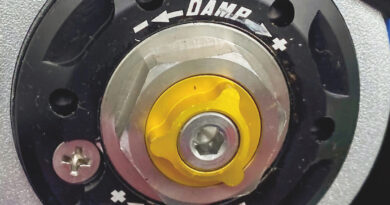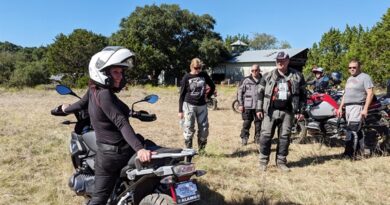Keeping Your Cool, Part 1: The Basics
Last summer’s record-breaking heat provided plenty of impetus to investigate more ways to stay comfortably cool on our motorcycles. Surely all serious riders have already developed some method(s) for coping with high temperatures, but some approaches are better than others, and some products specifically designed to beat the heat may not have come to every rider’s attention. Here we’ll review the fundamental principles underlying successful hot-weather motorcycling. In Parts Two, Three and Four we’ll look at a curated assortment of highly effective specialized gear.

First, what happens naturally without the use of any equipment? We all combat overheating with a combination of sweating and blood circulation. Our sweat glands excrete (primarily) water, which then—ideally—evaporates into the surrounding air. Anyone who has employed this bodily function in humid conditions and high temps knows it can be terribly inefficient, with much of the water generated simply dripping off the skin, rather than vaporizing into the atmosphere. It’s mainly that transformation from liquid to gas that actually delivers the cooling effect.
Without a comprehensive physics lesson, evaporation is a thermodynamic process requiring energy in the form of heat. Said energy breaks the bonds between water molecules in liquid form and sets them free to disperse into the air. This energy is taken from the water left behind, essentially subtracting heat from it. Since liquid water absorbs heat from (warmer) objects in contact with it, the temperature of our skin is reduced—it’s initially transferred to our sweat and subsequently handed off to the atmosphere. Certain environmental factors can facilitate or hinder this process. Humid air already contains lots of water vapor and therefore has less capacity for accepting more, so evaporative cooling is less effective in high humidity. Dry air has lots of “room” for liberated water molecules and boosts the cooling effect. Air circulation helps by replacing the gaseous layer that just absorbed water vapor (and became more humid/less absorbent) with a fresh supply of relatively drier air, ready to continue the process.
In addition to sweating, our circulatory systems aid the regulation of excessive body temperature by a) expanding blood vessels near the surface (vasodilation) to maximize the amount of blood benefiting from sweat’s cooling of the skin, and b) carrying this cooled blood deeper into the body, where it can reduce the temperature of our core and allow our organs to maintain normal functioning—a highly temperature-sensitive matter. Even tiny changes in our core temperature can have a profoundly negative impact on all sorts of essential processes. Think about how awful you can feel with a fever that’s just a few degrees higher than the standard 98.6. Now consider the fact heat exhaustion can cause people to precipitously lose consciousness, and heat stroke can be deadly. These dire consequences can occur in weather that might feel merely unpleasant during a brief outing but prove debilitating or lethal with the addition of physical exertion or prolonged exposure.

For obvious reasons, motorcyclists need to guard against bodily overheating. Reductions in mental acuity or physical performance could prove fatal due to rider error long before more extreme physiological effects become completely incapacitating. Some simpleminded common practices are apt to make things worse instead of better. For example, while in many situations shedding clothes may be helpful off the bike, foregoing protective gear while riding removes a barrier between sun and skin, increasing the body’s immediate absorption of radiant heat along with the risk of prolonged damage and discomfort from sunburn. Bare skin is also exposed to increased airflow, which may seem like a good thing at first. However, when liquid sweat is blown off instead of evaporating, it doesn’t produce the cooling effect described above, and when it evaporates too quickly, sweat glands can’t keep up. As we excrete more and more water to replace what’s removed by the fast-flowing airstream, we can quickly become dehydrated, which yields other serious problems in addition to those associated with overheating. There are good reasons why people in many extremely hot regions cover themselves completely in robes. This may be counter-intuitive, but they are insulating themselves from radiant and atmospheric heat and avoiding dehydration.
Mesh gear can be quite an effective solution on short duration outings, or in relatively mild heat. It maintains a barrier against solar energy (heat) and, of course, protection from impact and abrasion in the event of a fall. The strength of great mesh—its abundant ventilation—is also its weakness, as it can lead to overly fast evaporation of sweat in extreme conditions, similar to riding in just a t-shirt. (This downside applies to arid conditions, too.) There are two additional disadvantages: When the atmospheric temperature equals or exceeds that of our normal body temperature, we are no longer enjoying a cooling breeze through our mesh gear; in fact, we may be absorbing even more heat from the entering air (also true in a t-shirt). The result: mesh can actually be hotter to wear than non-mesh when the mercury has climbed way up. Also, much of evaporative cooling’s benefit is lost out the back of a mesh jacket, like running your air conditioning with all the windows open!
Any type of ventilated gear depends on access to moving air for its cooling effect. A motorcycle with a large, full-coverage fairing will obviously allow less airflow to reach the rider than a bike with a smaller fairing or no screen at all. Likewise, traveling at low speeds will yield less flow than going faster. Where your gear’s vents are located can make a big difference, too, along with their size and how well they stay open when exposed to the wind blast. Do the vents in your jacket/pants/helmet/gloves benefit or suffer from the shape of your bike’s fairing? Do they collapse and essentially close themselves in the riding position or amidst a powerful airstream? Note, too, that “breathable” membranes like Gore-Tex act as one-way valves, allowing moist air to escape but preventing wind from entering. Numerous factors can interact with your gear’s design to assist or interfere with airflow.
Many riders have learned the trick of soaking their t-shirt in water during gas stops, then regulating its evaporation with judicious use of their (non-mesh) jacket’s zippered vents. Water supplied from an outside source supplements/replaces that excreted by the sweat glands, so they don’t have to pull so much from the body. Limiting airflow through the jacket reduces the speed of evaporation, so the cooling effect lasts longer, and it creates a stable, temperate microclimate in the jacket’s interior, instead of promptly exiting into the rider’s wake. Anyone new to this practice will be astonished at how much cooling it can provide. I first learned it on a tour of the desert southwest in blistering triple-digit heat; it felt like I was sitting in a car with the A/C on high and the vents pointed directly at me! Unfortunately, although this method intensifies and extends the cooling effect beyond what’s achievable with sweat alone, a typical synthetic or cotton t-shirt (or even one made of the miraculous Merino wool) will dry out long before the next gas stop, and the rider must initially suffer the discomfort of wearing wet clothing—a worthwhile trade-off, but still unpleasant. Another cooling hack is the use of ice, either loaded in jacket pockets or (during stops) held against the skin where blood vessels are plentiful and close to the surface, like the wrists and neck. Again, the utility of these methods is limited, since they don’t last as long as a tank of gas. A rider must either stop more frequently or endure excessive heat for the latter portion of each leg of their journey.
Is there a better way? In Parts Two, Three and Four of this series, we’ll examine select products that exploit evaporative cooling and the functioning of our vascular radiators to enhance rider comfort and safety—and do so with fewer drawbacks than traditional methods. Keep in mind none of these will negate the need for frequent fluid intake when riding in even moderately high temperatures, and remember that caffeine is a diuretic, so you can’t count on coffee or most sodas to yield a net increase in hydration.



